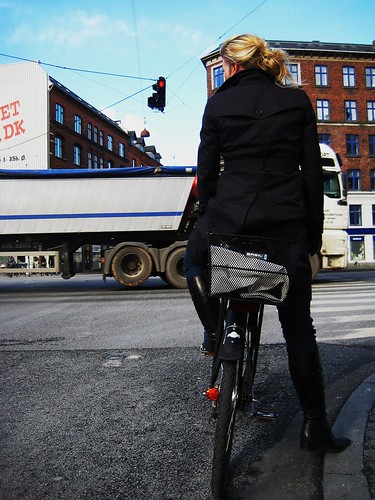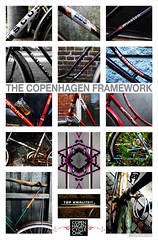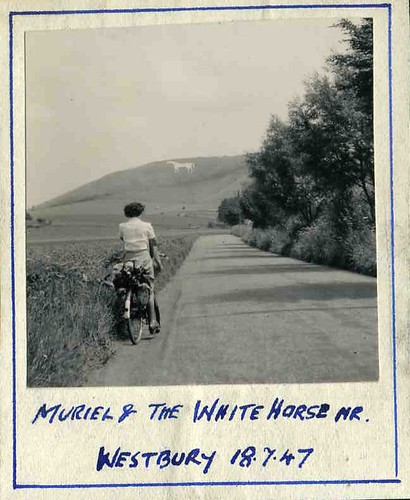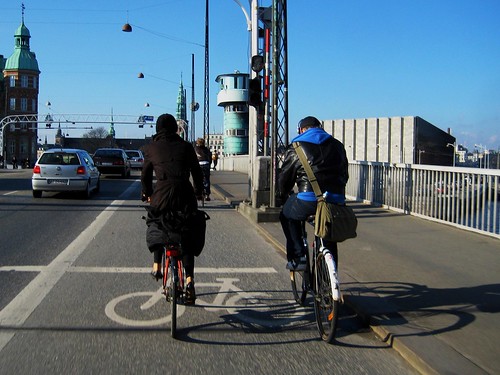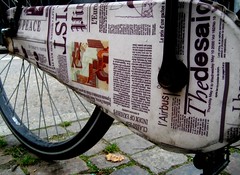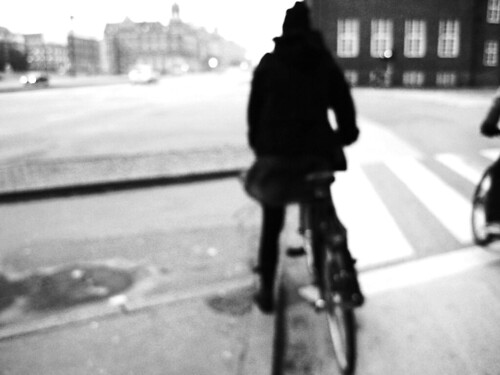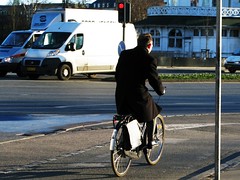In a previous post about Terminology Folly we tried to highlight how, in some countries, the bike industry love it when you buy into their tech-lingo. In Copenhagen it is a much simpler process.
Most of the features shown below are standard issue in Copenhagen and come with every new bike. You may have to piece together your own accessories, but here's the highlights.
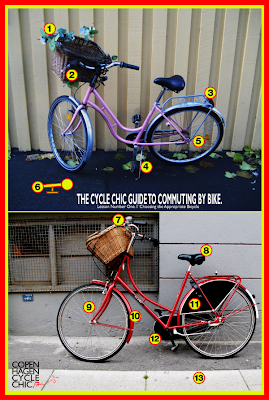
In no particular order of importance:
1. Personalise Your Bike
Copenhageners, mostly ladies, have been putting flowers on their baskets for the better part of a century. There are many ways of personalising your bicycle and only the fantasy sets the limit. Stickers, funky bells or horns, colourful baskets. It's up to you.
Flowers you can do yourself and stickers can be bought cheap, but for funky bike bells in North America you have to google kids+bike+accessories to enter the realm of cool bells.
LINKS:
- Bike Bells
[Know other cool links? Leave a comment.]




2. A Bicycle Basket [Cykelkurv]
The all important bicycle accessory, the basket. I'd be interested to see a statistic about the net weight of everything transported in Denmark by bike basket on a daily basis. Handbags, groceries, dogs, oh my.
Many bike baskets are hang on the handlebars and can easily be lifted off and carried into a shop or on a picnic. See the first thumbnail below. This detachable design is sturdy and good for heavy groceries. Copenhageners choose traditional wicker baskets as a rule but there are many cool designs out there. As Wifealiciousness says, she couldn't live without her basket.
LINKS:
- Bespoke, hand-crafted baskets by David Hembrow, shipped worldwide.
- Carrie Bicycle Basket from Sweden.
- Henandhammock.co.uk - Basket made from recycled plastic




3. Back Rack [Bagagebærer]
A handy addition to any bike. You have all that free space right behind your bum, why not use it?
4. Kickstand [Støtteben]
You simply cannot exist in Copenhagen without a kickstand. There are many bike racks, of course, but sometimes you either can't find a parking space or you just need to stand it up, lock the wheel lock and off you go.
5. Gears [Gearer]
This is one issue that gets discussed quite often. Most bikes in Copenhagen have 3 gears. The most irritating sound I know is someone accelerating off the light in one gear and then clickclickclickclickclick, they hop past 78 gears to get to the one they want. Why not just buy a bike with the gears you need?
We often hear that three gears don't fly in hilly cities. Then get five gears. The vast majority of cities in the world can be cycled daily in 3-5 gears. Whenever anybody says, "Yeah, but my city is REALLY hilly", we just politely refer to European cities like Berne, Switzerland, where 25% of the population ride each day through a Alpen landscape. Or hilly Aarhus, Denmark's second city, or Gothenburg, or Trondheim, Norway. 3-5 gears and off you go.
6. The Weight of Your Bicycle
To be honest... who cares. This strange North American fascination with a bicycle's weight has got to be the most irrelevant tech-spec in urban cycling history. It's a hangover from decades of the bicycle being a product of the the sports/hobby industry. Those times are changing now. They can start putting kickstands, fenders, back racks and baskets back on now. We're not out to win the Tour de France. We just want to ride with style over speed to work or down the supermarket, thank you very much.
Just choose a bike that you like. If you have to carry your bike up stairs to your flat, is 5 kilograms REALLY going to make a difference? When you've seen petite Copenhageners lifting their bikes up onto the upper rack of a double-decker bike rack at a train station, you realise that weight is unimportant.
7. Bicycle Bell [cykelklokke]
See #1 for some links. We've included it here because you should check your local traffic code to see if bells are legally required. They are in Copenhagen. Lack of one results in a fine.
8. Bicycle Seat [cykelsaddel]
If you're going to ride your European style bike 100 km a day, go to a sports shop for a sporty saddle. If you're going to pedal around town, get one that is comfy and cool. Brooks England saddles are becoming standard on new bikes in Copenhagen. They're lovely.
LINKS:
- Brooks England.
- Selle Royal.







9. Bike Lights [cykellygter]
#9 is on the wheel near the front fork because so many people in Copenhagen now use Reelights. They're always on and you never have to take them with you. Once again, check your local traffic laws regarding bike lights and reflectors.
In Copenhagen they must be on one hour before sunset until one hour after sunrise. Newspapers have Bicycle Weather for cyclists so you can check the times. See photo below. Here are the Danish bike light laws for your perusal - over at copenhagenize.com.
LINKS:
- Reelight





10. Fenders [skærme]
Once again, a must have in a rainy, windy city. Who on earth wants water or slush sprayed up onto their lovely shoes and trousers/skirt? Front and back fenders, please.
11. Skirt Guard [frakkeskåner]
Standard issue on new bikes. There is no reason to get your skirt oily or dirty. Handy for men who cycle in long coats or trenchcoats - the word for skirtguard in Danish is translated as "Coat Protector".. As an added bonus, if you put a child's seat on the back, the skirt guard protects their footsies from the spokes.
LINKS:
- Make your own skirt guard
- Cambridge Cycle Company UK


12. Chain Guard [kædeskærm]
Another 'can't live without it' accessory in Copenhagen. Why on earth would you pay good money for trousers only to roll them up? And a slash of oil doesn't look good on an ankle in high heels. Cover that chain up.
Hard to get in North America, unfortunately.
LINKS:
- Beautiful antique chain guards
- US - Bike Front
- Canada - The Urbane Cyclist
[Thanks for the links!]



13. Did We Forget Anything You Might Want to Know?
Let us know.
Trouser Clips! This was mentioned in the comments. Sögreni Bikes has a cool design.


